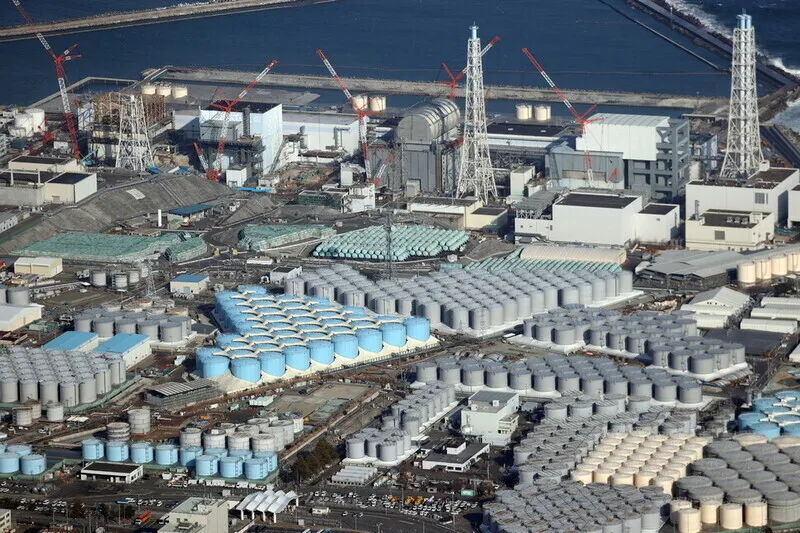hankyoreh
Links to other country sites 다른 나라 사이트 링크
Japan to dump second batch of Fukushima wastewater into ocean starting Thursday

Japan plans to begin releasing the second batch of radioactive wastewater into the ocean on Thursday from storage tanks at the Fukushima Daiichi nuclear power plant.
Kyodo News reported Tuesday that TEPCO, the Japanese power corporation that operates the plant, is preparing to release the second batch by measuring levels of tritium (a radioactive isotope of hydrogen) in the wastewater, which has been diluted with seawater. If the tritium concentration falls within tolerated levels, TEPCO will dump the second batch of wastewater into the ocean on Thursday as planned.
TEPCO intends to release around 7,800 metric tons of wastewater into the ocean in the second batch, just as in the first batch. The discharge will take about 17 days to complete, with around 460 metric tons of water flowing into the ocean each day.
TEPCO said though it had also detected four other radionuclides (carbon-14, cesium-137, cobalt-60 and iodine-129) in a sample of the wastewater that’s slated for release, the concentrations were all under the legally tolerated level. The power company plans to release a total of 31,200 metric tons of wastewater into the ocean in four batches through March 2024.
Between Aug. 24 and Sept. 11, TEPCO carried out its first release, discharging 7,788 metric tons of contaminated water into the ocean.
“An equipment checkup after the first release showed no issues,” the company stressed, adding that there were “no irregularities in the tritium concentrations in the surrounding waters.”
Procedures have also been initiated to provide compensation for damages resulting from the water’s release. TEPCO began accepting compensation applications on Monday and had reportedly already received documents from 40 parties.
TEPCO’s compensation is taking place separately from a fund of 80 billion yen (about US$547 million) established by the Japanese government. Compensation is to be provided for damages that arise regardless of region, industry, or time period. Neighboring countries such as South Korea are not eligible.
The first release of contaminated water is estimated to have resulted in the equivalent of around 90 billion won in losses for Japanese industries including fishing and tourism.
The biggest impact has come from a full-scale ban on Japanese seafood imposed by China in the wake of the water’s release. Russia is also considering a ban on seafood imports.
The Nikkei newspaper said that “losses have been large for companies exporting scallops and sea cucumber amid declining sales, as well as tourism businesses that have experienced reduced guest numbers.”
“Around 200 inquiries about compensation requests were reported nationwide in the last month,” the newspaper said.
By Kim So-youn, Tokyo correspondent
Please direct questions or comments to [english@hani.co.kr]

Editorial・opinion
![[Correspondent’s column] Coupang’s game in Washington follows familiar pattern [Correspondent’s column] Coupang’s game in Washington follows familiar pattern](https://flexible.img.hani.co.kr/flexible/normal/500/300/imgdb/original/2025/1226/8217667391873536.jpg) [Correspondent’s column] Coupang’s game in Washington follows familiar pattern
[Correspondent’s column] Coupang’s game in Washington follows familiar pattern![[Editorial] Coupang’s attempt to hide behind US won’t win back Korean consumers [Editorial] Coupang’s attempt to hide behind US won’t win back Korean consumers](https://flexible.img.hani.co.kr/flexible/normal/500/300/imgdb/original/2025/1226/1817667387971465.jpg) [Editorial] Coupang’s attempt to hide behind US won’t win back Korean consumers
[Editorial] Coupang’s attempt to hide behind US won’t win back Korean consumers- Coupang under fire for possible obstruction of investigation into its customer data leak
- [Editorial] Coupang founder’s contempt for workers, customer security knows no bounds
- [Column] Confessions of a Coupang-holic
- [Editorial] Kim Bom-suk’s arrogance on full display in boycott of Coupang leak hearing
- [Editorial] The facts of Yoon’s insurrection are clear — justice cannot be further delayed
- [Column] Trump destroys government
- [Column] A post-Western world approaches
- [Column] Offshore balancing, or carving out spheres of influence?
Most viewed articles
- 1Korea to trial next-gen train capable of sub-2-hour Seoul-Busan trip starting 2030
- 2Kim Jong-un’s hidden motive in criticizing South Korea’s nuclear submarine push
- 3[Editorial] Coupang’s attempt to hide behind US won’t win back Korean consumers
- 4Coupang under fire for possible obstruction of investigation into its customer data leak
- 5[Correspondent’s column] Coupang’s game in Washington follows familiar pattern
- 6Real-life heroes of “A Taxi Driver” pass away without having reunited
- 7Moon Jae-in renews call for end-of-war declaration, peace treaty on Korean Peninsula
- 8Chang Chun-ha’s family hopes to know truth of his death after 37 years
- 9Chinese money flooding into South Korean companies
- 10Russian architect personally witnessed Empress Myeongseong’s assassination by Japanese ronin, accoun